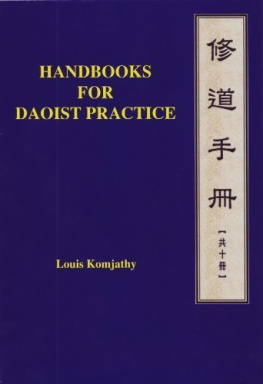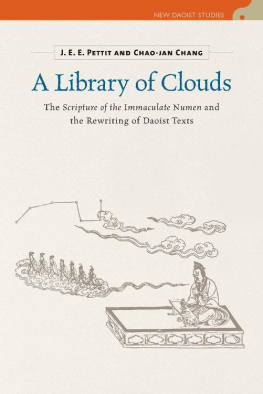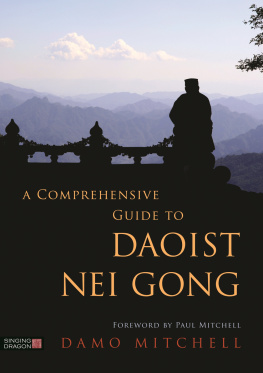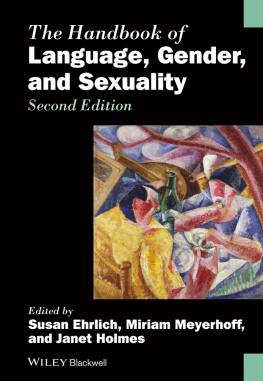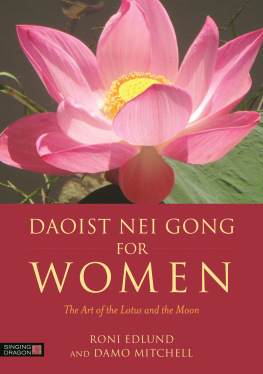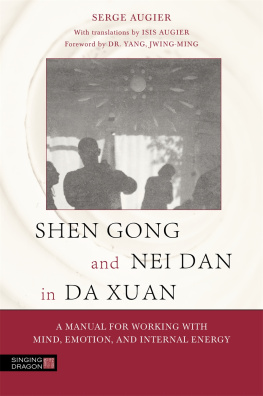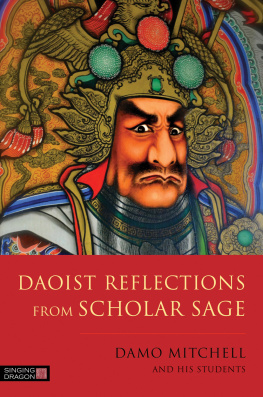Louis Komjathy - Handbooks for Daoist Practice
Here you can read online Louis Komjathy - Handbooks for Daoist Practice full text of the book (entire story) in english for free. Download pdf and epub, get meaning, cover and reviews about this ebook. genre: Religion. Description of the work, (preface) as well as reviews are available. Best literature library LitArk.com created for fans of good reading and offers a wide selection of genres:
Romance novel
Science fiction
Adventure
Detective
Science
History
Home and family
Prose
Art
Politics
Computer
Non-fiction
Religion
Business
Children
Humor
Choose a favorite category and find really read worthwhile books. Enjoy immersion in the world of imagination, feel the emotions of the characters or learn something new for yourself, make an fascinating discovery.
- Book:Handbooks for Daoist Practice
- Author:
- Genre:
- Rating:4 / 5
- Favourites:Add to favourites
- Your mark:
- 80
- 1
- 2
- 3
- 4
- 5
Handbooks for Daoist Practice: summary, description and annotation
We offer to read an annotation, description, summary or preface (depends on what the author of the book "Handbooks for Daoist Practice" wrote himself). If you haven't found the necessary information about the book — write in the comments, we will try to find it.
Handbooks for Daoist Practice — read online for free the complete book (whole text) full work
Below is the text of the book, divided by pages. System saving the place of the last page read, allows you to conveniently read the book "Handbooks for Daoist Practice" online for free, without having to search again every time where you left off. Put a bookmark, and you can go to the page where you finished reading at any time.
Font size:
Interval:
Bookmark:
The Handbooks for Daoist Practice were previously circulated in a private printing under the imprint of Wandering Cloud Press, 2003.
2008 The Yuen Yuen Institute
All rights reserved
ISBN: 978-988-98980-1-4
Published by The Yuen Yuen Institute,
The Yuen Yuen Institute,
Sam Dip Tam. Tsuen Wan, N.T., Hong Kong.
Fax: +852 2493 8240
E- mail: admx@yuenyuen.org.hk
Web- site: www.yuenyuen.org.hk
Printed in Hong Kong
Introduction to Handbooks for Daoist Practice
Orientations
During recent years, I have had the opportunity to meet and speak with various Daoist teachers, dedicated practitioners, and interested students about the Daoist tradition. In a variety of contexts, public talks, course lectures, conferences, seminars, and practice sessions, many have expressed a sincere interest in deepening their understanding and practice of Daoism. This series of translations, these handbooks for Daoist practice, are for them and those who follow.
Handbooks for Daoist Practice (Xiudao shouce ) consists of ten handbooks. These include handbooks two through ten (the nine booklets that are the Daoist translation series proper). These are translations of nine important, representative, and praxis-orientated Daoist texts. The first (or tenth) handbook is an introduction to the series as a whole.
In this introductory handbook, I discuss Daoism as a Chinese religious tradition and Daoists as those for whom cultivating the Dao (xiudao ) is their fundamental concern; important publications in the field of Daoist Studies, which may serve as resources for self-education; some philosophical issues in the study of Daoism; significant aspects of the history and development of the Daoist tradition; principles for Daoist practice; the importance of scripture study; the motivations behind my choice of texts deserving translation; and my translation methodology.
Daoism (Taoism) is a Chinese religious tradition in the process of being transmitted and adapted to a global context. On the most basic level, Daoism refers to an indigenous Chinese religious tradition(s) in which reverence for and veneration of the Dao (Tao) , translatable as both the Way and a way, is a matter of ultimate concern. In contrast to adherents of other Chinese religious and cultural traditions, Daoists (Taoists) understand the Dao as Source of all that is, unnamable mystery, all-pervading numinosity, and the cosmological process which is the universe. The Dao is impersonal and simultaneously immanent and transcendent. Broadly understood, the point of a Daoist way of life is to cultivate alignment and attunement with the Dao.
Daoism is a Chinese religious tradition. Daoism is Chinese because it originates in Chinese culture and, in some sense, because it is most clearly understood through Chinese language and views of being. Daoism is a religion because it involves an orientation towards and relationship with the sacred. Daoism is a tradition because it is a community of dedicated practitioners connected to each other as a historical and energetic continuum.
At the same time, Daoism is now being transmitted and adapted to a global context. Daoism is no longer merely a Chinese religious tradition. It is now a global religious and cultural phenomenon(a), existing in Australia, Brazil, Canada, Denmark, England, France, Italy, Korea, Singapore, Thailand, and Vietnam, and practiced by people of a wide variety of ethnic backgrounds. It is also slowly becoming established in the United States in various forms, with varying degrees of connection with the earlier Chinese religious tradition. Without an understanding of such historical precedents, Daoism in the West will simply be a fabrication, a fiction, and a fantasy. This does not mean that there should not be adaptation and modification; change necessarily occurs when a religious tradition enters a new cultural context and when religious practitioners have different concerns and motivations. But it does mean that without a connection and collective memory such innovations become meaningless names.
The Daoist tradition is a community of practitioners connected to each other as a historical and energetic continuum. Daoists are those for whom cultivating the Dao (xiudao )is their most important orientation.
The identity of Daoists derives from their being and presence. One is a Daoist based on the extent to which one is aligned with and embodies the Dao in its multi-layered numinosity. One is a Daoist based on the extent to which one embodies Daoist principles and follows a Daoist way of life.
Daoist identity does not come from some supposed orthodoxy associated with Zhang Daoling , the receipt of registers (lu ), religious licenses, and/or some magico-ritual performance. This is the province of certain Daoist priests (daoshi ), which must be recognized as one way among many revealed by the historical contours of the Daoist tradition. The models of Daoist practice-realization, established, modified, and confirmed through some 2,000 years of history, are many and varied.
Daoists recognize the Dao as Source, all-pervading mystery, and immanent numinosity. The immanent numinosity of the Dao pervades ones being; it is ones innate nature and innate capacities. Throughout Daoist history, the Dao has become manifest through the revelations of specific deities and immortals, through their interaction with and self-disclosure to human beings. From the perspective of classical Daoist theology (discourse on the sacred), based on emanation and immanence, such divine beings are embodiments of the Dao.
Fortunately, for the interested student of Daoism developments in Daoist Studies over the last ten years have been dramatic. There are now a variety of resources for the study of Daoism. We now have books that are written by specialists but not only for specialists. These include both introductory articles on the Daoist tradition (Seidel 1978; Baldrian 1987; Kirkland 1997; 2000; 2002; Schipper 2000) and book-length introductions by trustworthy and competent members of the field of Daoist Studies (Robinet 1997; Kohn 2001a; Miller 2003; Kirkland 2004; Torchinov forthcoming). Students will also want to consult two important reference works, namely, the Daoism Handbook (Kohn 2000a) and The Encyclopedia of Taoism (Pregadio forthcoming). Helpful timelines of Daoist history may be found in Julian Pas Historical Dictionary of Taoism (1998) and in Livia Kohns Daoism and Chinese Culture (2001a). For those interested in the various ways in which Daoism has been understood, interpreted, and constructed, J.J. Clarkes The Tao of the West (2000) deserves careful reflection.
Interested readers may also want to access other resources for self-education. Some very helpful bibliographies have been compiled. The seminal publication in this area is Anna Seidels Chronicle of Taoist Studies in the West (1989-90). Also well done and fairly available are Julian Pas A Select Bibliography of Taoism (1997 [1988]), much of which also appears in his Historical Dictionary of Taoism (1998), and Knut Walfs Westliche Taoismus- Bibliographie / Western Bibliography of Taoism (2002 [1997]). These guides may be supplemented by the bibliographies for the various articles contained in the Daoism Handbook.
Because of the relatively recent ascendancy of the internet or World Wide Web (WWW) as the most easily accessible source of information, some websites deserve mention. But first a caveat: discernment is a human faculty too rarely employed, especially with regard to the internet. There are differences among information, knowledge, and wisdom. Here I am speaking pragmatically. Information is simply unrefined stuff; believing that information for its own sake is beneficial or makes any contribution is similar to believing that unlimited consumption, the acquisition of manufactured goods, makes life worth living. Information is frequently disseminated by those who have not dedicated themselves to the study and skills required to represent things accurately, that is, beyond the limitations and deficiencies of ones own personality, unquestioned assumptions, and habitual perception. Knowledge, in contrast, has been filtered and refined more thoroughly. Knowledge evidences fundamental qualities: consideration, reflection, discernment, and evaluation. The attainment of knowledge involves being an engaged being. It also requires an openness that benefits from those who have dedicated themselves to study and the search for accuracy. One might, in turn, suggest that it is knowledge in the service of life that is most needed. Moreover, as the Laozi (Lao-tzu; Book of Venerable Masters) explains, To know that you do not know is best;/To not know that you are knowing is sickness./To be sick of sickness is the end of sickness (ch. 71). Knowledge is not something to be used as a way of inflating ones ego or dominating others. One must always recognize how little one actually knows and that knowing itself is often a limitation. Thus, chapter two of the Zhuangzi (Chuang-tzu; Book of Master Zhuang) informs us, One who dreams of drinking alcohol may weep when morning comes; one who dreams of weeping may in the morning go off to hunt. While you are dreaming you dont know its a dream, and in this dream you may even attempt to interpret the dream. Only after you wake up do you know it was a dream. Someday there will be a great awakening ( dajue ) when we know that all this is a great dream ( dameng ). And yet, the ignore-ant believe they are awake, deceptively assuming they understand things. They call this man lord, that one commoner how dense! Qiu (Confucius) and you are both dreaming! And when I say you are dreaming, I am dreaming too.
Next pageFont size:
Interval:
Bookmark:
Similar books «Handbooks for Daoist Practice»
Look at similar books to Handbooks for Daoist Practice. We have selected literature similar in name and meaning in the hope of providing readers with more options to find new, interesting, not yet read works.
Discussion, reviews of the book Handbooks for Daoist Practice and just readers' own opinions. Leave your comments, write what you think about the work, its meaning or the main characters. Specify what exactly you liked and what you didn't like, and why you think so.

